Seizures of drugs, in England and Wales, financial year ending 2020
Updated 8 January 2021
Applies to England and Wales
Frequency of release: Annual
Forthcoming release: Home Office statistics release calendar
Home Office responsible statistician: Daniel Shaw
Press enquires: pressoffice@homeoffice.gov.uk Telephone: 020 7035 3535
Public enquires: drugseizures.datacollection@homeoffice.gov.uk
This statistical release presents figures for drug seizures made in the year ending 31 March 2020 in England and Wales by the police (including the British Transport Police) and Border Force. The data relate to all drugs controlled under the Misuse of Drugs Act 1971 (MDA), which divides drugs into three categories – Classes A, B and C – according to the harmfulness they cause to the user or to society when they are misused. Class A drugs are considered to be the most harmful. This statistical release also presents figures relating to drugs known as new psychoactive substances (NPS).
Key results
- Police forces and Border Force made a total of 183,068 drug seizures in England and Wales in year ending March 2020, a 20% increase compared with the previous year (153,136). This is the second consecutive annual increase in seizures, reversing a downward trend since year ending March 2012.
Number of seizures of Class A, B and C drugs, police forces and Border Force, years ending March 2007 to 2020

- Seizures of Class A drugs increased by 13% between years ending March 2019 and 2020.
- Seizures of cocaine by police forces and Border Force increased by 10% from year ending March 2019 but the quantity of cocaine seized decreased by 5,371kg, from 9,645kg in that year to 4,274kg in the latest year.
- Seizures of crack by police forces and Border Force increased by 7% since year ending March 2019, the highest number of seizures since year ending March 2008. The quantity of crack seized increased by 35% and is the highest amount seized since year ending March 2005.
- Seizures of Class B drugs increased by 11% between years ending March 2019 and 2020 with 94% of all Class B seizures involving at least one form of cannabis.
Executive summary
This statistical release presents figures for drug seizures made in the year ending 31 March 2020 in England and Wales by the 44 police forces (including the British Transport Police) and Border Force. The data relate to all drugs controlled under the Misuse of Drugs Act 1971 (MDA), which divides drugs into three categories (Classes A, B and C) according to the harm they cause to the user or to society when they are misused. Class A drugs are considered to be the most harmful.
Five police forces were unable to provide complete data for year ending March 2020. These forces were: Hertfordshire Constabulary, Kent Police, Lincolnshire Police, Greater Manchester Police and Sussex Police. As a result, imputation methods have been used to estimate data for these forces, as described in the user guide. All comparisons in this publication include the estimated values.
The number and quantity of seizures made can be affected by police and Border Force activity and changes in recording practices, as well as changes in the drugs market. Therefore, the number and quantity of drug seizures each year should not be taken as an indicator of drug prevalence in England and Wales. Statistics on prevalence can be found in the Drug Misuse publications, based on results from the Crime Survey for England and Wales[footnote 1] and the Smoking, Drinking and Drug Use among Young People in England survey[footnote 2]. Further information on these statistics are in the user guide.
Key findings
- A total of 183,068 drug seizures were made in England and Wales in the year ending March 2020, a 20% increase compared with the previous year (153,136). This is the second consecutive annual increase in seizures, reversing a declining trend since the year ending March 2012. This increase is mainly driven by an increase in the number of seizures of Class B drugs.
- There were increases in the number of seizures made by police forces (up by 17% from 144,198 to 169,224) and by Border Force (up 55% from 8,938 to 13,844).
- Cannabis was the most commonly seized drug, which was involved in 71% of all drug seizures in England and Wales in the year ending March 2020. The second most commonly seized drug was cocaine, which was involved in 10% of all seizures.
- Trends in the number of seizures are driven by police force activity, as the vast majority (92%) were made by them.
- While Border Force seizures made up a small proportion of the total number of seizures, they tended to comprise much larger quantities. This reflects that seizures made by police forces are dominated by the apprehending of individuals with smaller quantities of drugs, for example for personal consumption, whereas Border Force will catch those involved in the trafficking of larger quantities for supply. In terms of quantity, Border Force seized 92% of heroin, 88% of cocaine, 81% of herbal cannabis, 79% of anabolic steroids, 77% of cannabis resin and 67% of ecstasy.
Class A
- Seizures of Class A drugs increased by 13% in the years ending March 2019 and 2020, from 32,754 to 37,127 seizures. Cocaine was the most commonly seized Class A drug, with 51% of all Class A seizures involving this substance in the year ending March 2020.
- There were 18,790 seizures of cocaine in the year ending March 2020, up by 10% compared to the previous year (17,038 seizures). The quantity of cocaine seized decreased from 9,645kg in the year ending March 2019 to 4,274kg in 2020, a decrease of 5,371kg. The quantity of cocaine seized in the year ending March 2019 was particularly large, so the quantity of cocaine seized in the latest year was similar to that seized in the other years of the past decade.
- In the year ending March 2020, 2 million doses of ecstasy were seized. This is a 9% decrease from the previous year when 2.2 million doses were seized, but is higher than in the other years of the past decade.
- There were 178,193 doses of LSD seized in the year ending March 2020, a 230% increase compared to the previous year (54,070 doses). This was the highest quantity of LSD seized since the year ending March 2005[footnote 3] when 1,137,000 doses were recorded.
- Seizures of crack by police forces and Border Force increased by 7%, from 6,561 in the year ending March 2019 to 7,050 in the latest year, the highest number of seizures since the year ending March 2008. The quantity of crack seized increased by 35%, from 63kg in the year ending March 2019 to 84kg in the latest year, the highest amount seized since the year ending March 2004[footnote 4] .
- There were 27 seizures of fentanyl and 5 seizures of fentanyl analogues by police forces and Border Force in the year ending March 2020. This is the second year that data on fentanyl seizures have been published separately from the ‘Other Class A drugs’ category.
Class B
- Seizures of Class B drugs increased by 21% between the years ending March 2019 and 2020, from 115,047 to 138,791 seizures. Cannabis was the most commonly seized Class B drug, with 94% of all Class B seizures involving this substance in the year ending March 2020.
- Approximately 84% of cannabis seizures involved herbal cannabis. Between the years ending March 2019 and 2020, the number of seizures of herbal cannabis rose by 22%, from 95,549 to 116,575 seizures. Border Force had 5,019 seizures of herbal cannabis, the highest number since the year ending March 1996[footnote 5], when there were 6,661 seizures.
- The quantity of herbal cannabis seized increased by 68% compared with the previous year, from 16,692kg in the year ending March 2019 to 28,052kg in 2020.
- There was an 81% decrease in the quantity of cannabis resin seized (from 4,626kg to 871kg) between years ending March 2019 and 2020, while the number of cannabis plants seized increased by 24% (from 395,843 plants to 490,254 plants).
Class C
- Seizures of Class C drugs increased by 9% between the years ending March 2019 and 2020, from 5,282 to 5,778 seizures. The most commonly seized Class C drug in the year ending March 2020 was ‘Other Class C’ (e.g. Tramadol, Zopiclone, Khat) with 2,867 seizures, a 20% increase on the previous year.
- Between the years ending March 2019 and 2020, there was a 51% increase in the quantity of benzodiazepines seized, from 0.6 million to 0.9 million doses.
- There was a 50% decrease in the quantity of anabolic steroids seized between the years ending March 2019 and 2020, from 2.7 million to 1.3 million doses.
New psychoactive substances (NPS)
- There were 2,667 seizures of NPS by police forces in the year ending March 2020, a decrease of 2% from the previous year when the number of seizures was 2,717.
- The most commonly seized types of NPS by police forces in the year ending March 2020 were synthetic cannabinoids (2,055 seizures), other NPS (275 seizures), NPS powders (97 seizures) and nitrous oxide (241 seizures).
1. Introduction
This publication presents figures for drug seizures made in the year ending March 2020 in England and Wales by the territorial police forces (and the British Transport Police) and Border Force. Although Border Force will have made seizures outside the land territory of England and Wales (e.g. Scotland, Northern Ireland), such seizures are excluded from figures presented in this publication.
Drug seizures often involve the seizure of multiple types of drugs. This means that the sum of seizures by each drug type will exceed the overall number of seizures. For example, if cocaine and cannabis resin were both seized in one seizure, this would be counted as one seizure in the overall total but would be counted twice in the breakdown by drug type (one seizure of cocaine plus one seizure of cannabis resin).
This publication reports on trends in drug seizures across England and Wales for the year ending March 2020. This publication is largely unaffected by the coronavirus (COVID-19) pandemic, as it mainly relates to the period prior to the lockdown.
In the year ending March 2018, figures for seizures of drugs referred to as new psychoactive substances (NPS) were presented in this publication for the first time. NPS refers to newly available drugs that mimic the effect of existing drugs such as cannabis, ecstasy and powder cocaine. Some NPS are controlled under the Misuse of Drugs Act 1971 (MDA)[footnote 6], while other NPS are illegal to supply, produce and import under the Psychoactive Substances Act 2016[footnote 7]. The year ending March 2018 was the first year that data on NPS had been recorded systematically across police forces and Border Force. However, Border Force were unable to provide separate figures for total NPS and synthetic cannabinoids seizures in the year ending March 2020. Data is presented for the years ending March 2019 and 2020, however these statistics remain designated as Experimental Statistics, as they are not yet fully developed and do not meet the rigorous quality standards of National Statistics.
In 2019 the Home Office moved its drug seizures records to a different database. Drug seizures figures from previous years have not been revised following this change, but historical figures may be revised in future publications, which is expected to lead to small changes in drug seizures figures and unlikely to affect overall trends. We will inform users of these statistics of any revisions made in future publications.
Five police forces (Hertfordshire Constabulary, Kent Police, Lincolnshire Police, Greater Manchester Police and Sussex Police) were unable to provide fully accurate data for the year ending March 2020. As a result, imputation methods have been used to estimate data for these forces, as outlined in the user guide. All comparisons in this publication include the estimated values.
Data on the number of seizures and quantity of drugs seized in England and Wales can be found in the accompanying spreadsheet tables.
1.1 Substances covered by this release
The statistics covered by this release relate to all drugs controlled under the MDA, which divides drugs into three categories – Classes A, B and C – according to the harm they cause to the user or to society when they are misused. Class A drugs are considered to be the most harmful. Given the large number of drugs covered by the MDA, it is not feasible to publish seizure statistics in detail for every drug type. While all drugs are included in the totals, only those shown below are covered in detail within this bulletin[footnote 8]. This bulletin also captures the number of seizures where the substance, and therefore its classification, were unknown.
Table 1: Drugs and their classifications under MDA 1971
| Class A | Class B | Class C |
|---|---|---|
| Cocaine | Amphetamines* | Anabolic steroids |
| Crack | Barbiturates** | Benzodiazepines |
| Ecstasy | Cannabis** | GHB |
| Heroin | Ketamine*** | Temazepam |
| LSD | Mephedrone | |
| Methadone | ||
| Morphine |
Notes:
* Amphetamines and barbiturates are Class A drugs if prepared for injection.
** Cannabis was reclassified from a Class B to a Class C drug in January 2004, and then classified back to a Class B drug on 26 January 2009. Cannabis is counted as a Class B drug for the entire time series in this publication.
*** Ketamine was reclassified from a Class C to a Class B drug on 10 June 2014. Ketamine is counted as a Class C drug for the entire time series in this publication.
For consistency, drugs are counted against their current classification for all years shown. For example, cannabis is counted as a Class B drug for the entire time series.
This is the third year that information on seizures of NPS are covered in this publication and the second year that fentanyl and fentanyl analogues are reported separately from the ‘Other Class A drugs’ category.
As with previous years, Border Force have not reported separately some of the drugs included in the above table. This has resulted in Border Force seizures of methadone being included within the ‘Other Class A’ grouping, synthetic cannabinoids and barbiturates within ‘Other Class B’, and benzodiazepines, GHB and temazepam within ‘Other Class C’.
2. Number of seizures
- In the year ending March 2020, there were 183,068 seizures of drugs in England and Wales, a 20% increase from the previous year, when there were 153,136 seizures[footnote 9].
- The number of drug seizures peaked in the year ending March 2009 at 241,473 seizures and declined by 24% down to 183,068 seizures in the latest year (Figure 1). This is the second consecutive year that there has been an annual increase in the number of seizures, reversing a downwards trend since the year ending March 2012. The increase was driven by increased seizures of a range of drugs including cannabis, cocaine, crack, heroin and LSD.
- As in previous years, the majority of seizures were for Class B drugs, and in particular cannabis. More than three-quarters (76%) of all seizures involved cannabis (herbal, resin or plant).
Figure 1: Number of seizures of Class A, Class B and Class C drugs, police forces and Border Force, years ending March 2007 to 2020

Source: Home Office, Summary Table 1.
Chart notes
* For consistency, drugs are counted in their current classification for the entire time series shown.
The number of seizures made can be affected by police activity and changes in recording practices. Therefore, the number of drug seizures each year should not be taken as a measure of drug prevalence in England and Wales. Prevalence is presented in the Drug Misuse publications, based on results from the Crime Survey for England and Wales[footnote 10] and the Smoking, Drinking and Drug Use among Young People in England survey[footnote 11].
The total number of drug seizures per year follows a similar trend to the number of police recorded drug offences (Figure 2)[footnote 12]. In the year ending March 2020, the police recorded 182,513 drug offences[footnote 13], an 18% increase from the previous year (154,067). Over the same period, the number of seizures by police forces alone, excluding Border Force, also increased by 17%. Other statistics[footnote 14] show that more proactive policing has led to a rise in stop and search by police forces in England and Wales which has contributed in a rise in the number of police recorded drug offences and this is likely to be a significant driver of the increase in the number of drug seizures by police.
Since the peak in the year ending March 2009, the number of drug offences recorded by the police has decreased by 25% (from 243,536 to 182,513) and the number of drug seizures by police forces has also decreased by 28% (from 233,793 to 169,224).
Figure 2: Index of police recorded drug offences and the total number of drug seizures by police forces, years ending March 2007 to 2020
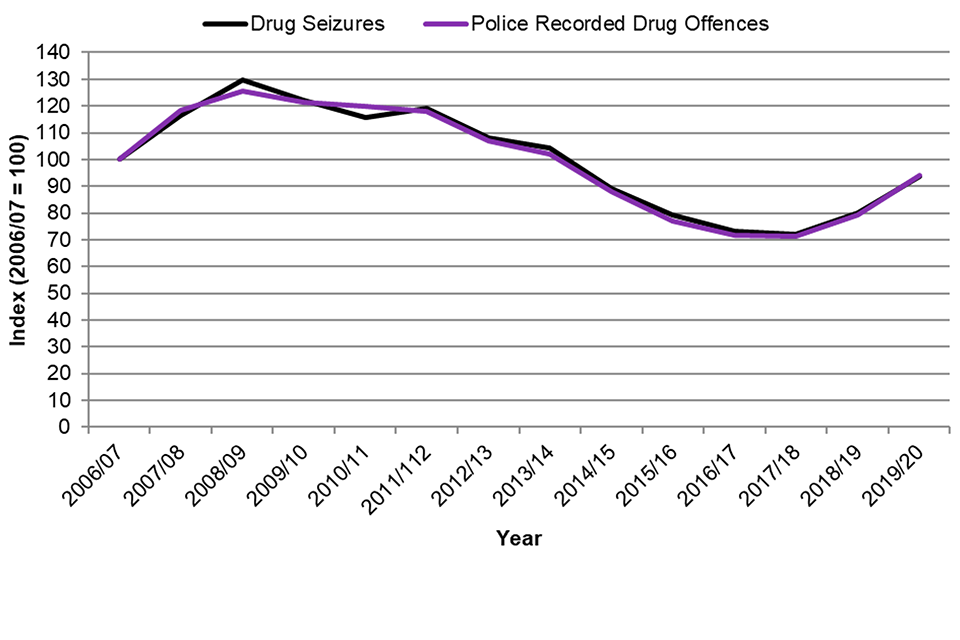
Source: Home Office, Summary Table 1. Office for National Statistics (ONS), Crime in England and Wales, year ending March 2020, Appendix Table A4.
2.1 Class A drugs
In the year ending March 2020, there were 37,127 seizures of Class A drugs, a 13% increase on the previous year (32,754 seizures). In the latest year, 20% of all drug seizures involved at least one Class A drug. Since the year ending March 2007, cocaine has been the most commonly seized drug in this classification group; prior to this year, heroin had been the most commonly seized Class A drug[footnote 15].
- Over half (51%) of all seizures of Class A drugs involved cocaine, with 18,790 seizures in the year ending March 2020, a 10% increase on the previous year’s figure (17,038). As shown in Figure 3, the number of cocaine seizures had previously followed a downward trend since the peak in the year ending March 2009.
- After cocaine, heroin was the second most commonly seized Class A drug, with 8,742 seizures in the year ending March 2020 (24% of all Class A seizures), a 4% increase on the previous year of 8,444 seizures (Figure 3).
- There was an increase in the number of seizures of the following drugs:
- Crack seizures were up 7% from 6,561 in the year ending March 2019 to 7,050 in the latest year, the highest number since the year ending March 2008 (7,191) (Figure 3). Almost 100% of all crack seizures were made by police forces.
- Other Class A seizures were up 93% from 1,775 to 3,421.
- LSD seizures were up 160% from 200 to 519 (the highest since 2000 when there was 240 seizures).
- Ecstasy seizures were up 10% from 3,147 to 3,468.
- Methadone seizures were up 5% from 407 to 427.
- There was a 20% decrease in the number of seizures of morphine from 204 to 163.
Figure 3: Number of seizures of the main Class A drug types, police forces and Border Force, years ending March 2007 to 2020
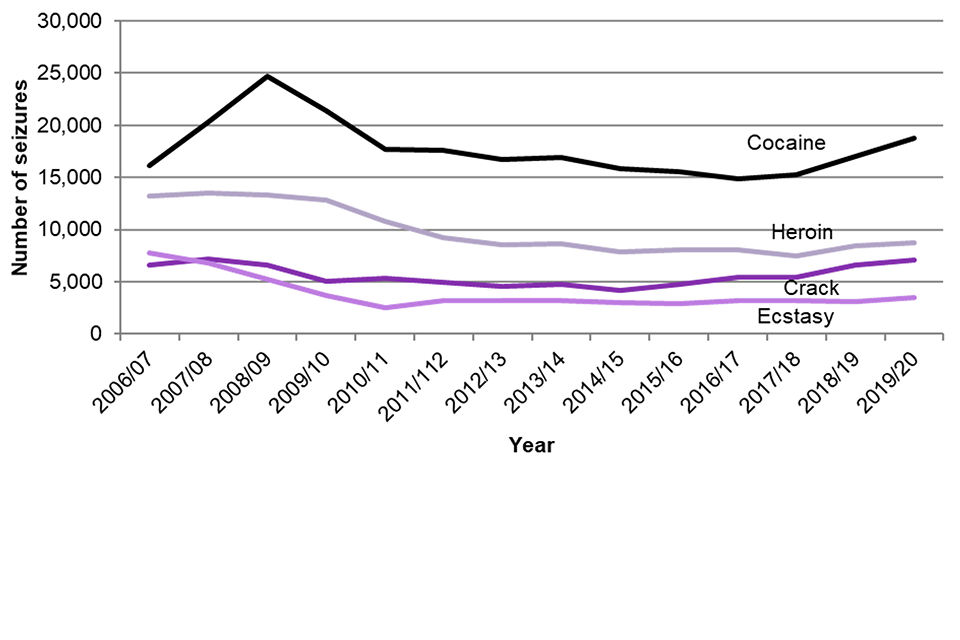
Source: Home Office, Summary Table 1.
- There were 27 seizures of fentanyl and 5 seizures of fentanyl analogues in the year ending March 2020 (Figure 4)[footnote 16].
Figure 4: Number of seizures of fentanyl and fentanyl analogues, by police forces and Border Force, years ending March 2012 to 2020
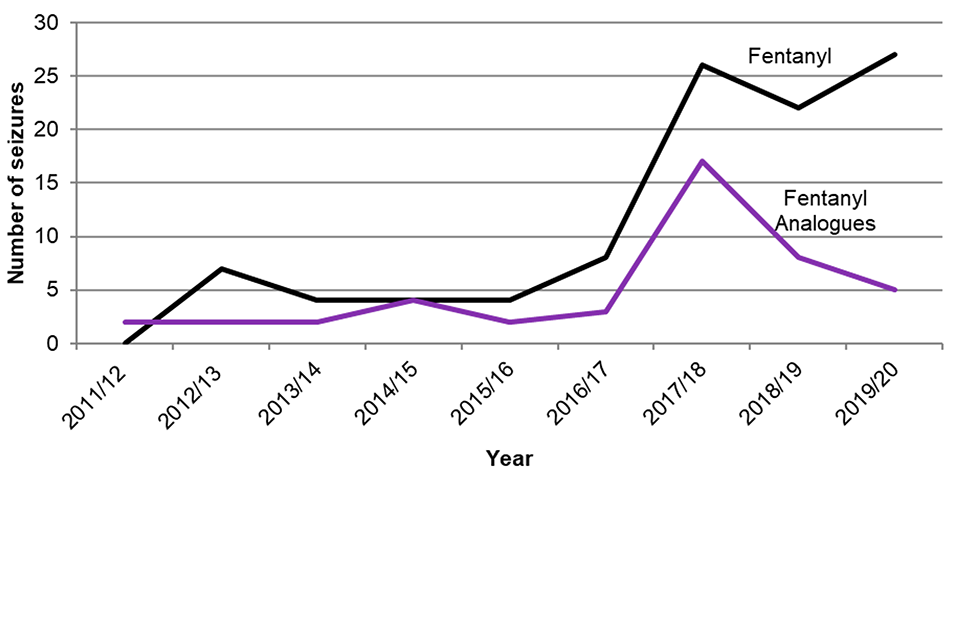
Source: Home Office, Appendix Table 3.
2.2 Class B drugs
In the year ending March 2020, there were 138,791 seizures of Class B drugs, a 21% increase compared with the previous year (115,047 seizures). As in previous years, the great majority of Class B seizures were for cannabis, with 95% of all Class B seizures involving at least one form of cannabis (130,751).
2.2.1 Cannabis
- There were 130,751 seizures of cannabis in the year ending March 2020, a 21% increase from the previous year (108,362).
- Cannabis seizures have increased each year since the year ending March 2018, following a general decline in cannabis seizures since the year ending March 2012, as shown in Figure 5. This increase is driven by an increase in seizures of herbal cannabis and cannabis resin.
- Seizures of herbal cannabis (which dominate seizures of cannabis) increased by 22% between the years ending March 2019 and 2020 (from 95,549 to 116,575). Seizures of cannabis resin increased by 20% (from 6,583 to 7,912). Seizures of cannabis plants increased by 4% from 8,663 to 8,984.
Figure 5: Number of cannabis seizures, police forces and Border Force, years ending March 2007 to 2020
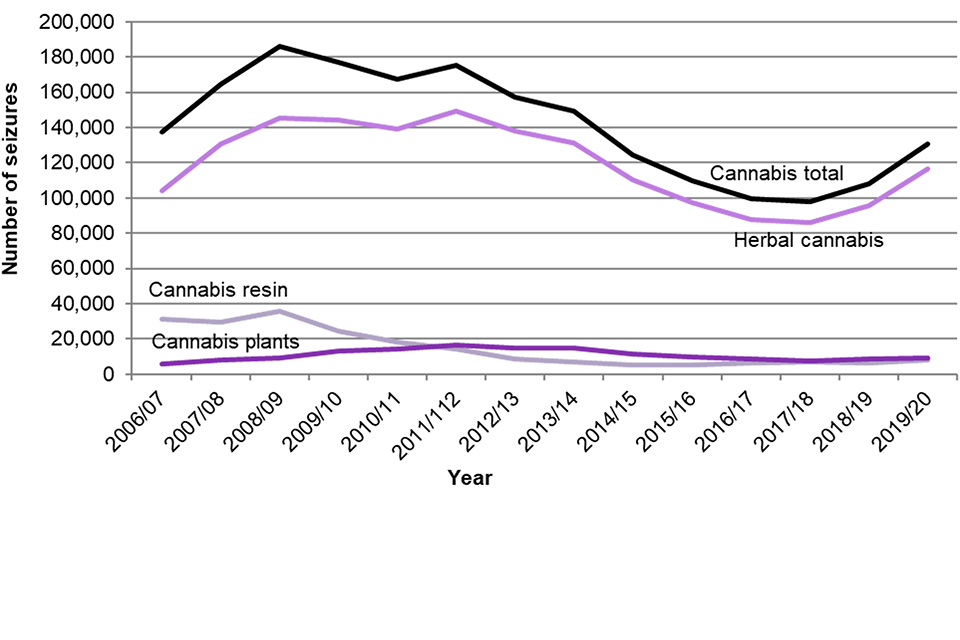
Source: Home Office, Summary Table 1.
2.2.2 Other Class B drugs
- Amphetamines were the second most frequently seized Class B drug with 3,606 seizures in the year ending March 2020, a 2% decrease on the previous year when there were 3,664 seizures. Amphetamine seizures have been declining since the year ending March 2008, when there were 8,414 seizures.
- In the year ending March 2020, there were 1,256 seizures of ketamine, a 31% increase on the previous year when there were 959 seizures. This increase is mostly driven by seizures by police forces, which accounted for 85% of all ketamine seizures in the year ending March 2020.
- The number of seizures of mephedrone increased by 21%, from 63 in the year ending March 2019 to 76 in the latest year. There has been a long-term decline since the year ending March 2013, when there were 3,850 mephedrone seizures.
- The number of seizures of ‘Other Class B’ drugs in the year ending March 2020 (4,883) was 37% higher than in the previous year (3,554).
2.3 Class C drugs
- There was a 9% increase in the number of seizures of Class C drugs in the year ending March 2020 compared with the previous year, from 5,282 to 5,778 seizures.
- 39% of all seizures of Class C drugs involved benzodiazepines, with the number of seizures increasing by less than 1% between the years ending March 2019 and 2020 (2,249 to 2,250).
- In the year ending March 2020, there were 2,867 seizures of ‘Other Class C’[footnote 17] drugs, a 20% increase compared with the previous year (2,383 seizures).
2.4 Unknown substances
In the year ending March 2020, the number of seizures of unknown substances increased by 18% compared with the previous year, from 11,489 to 13,576.
3. Quantity of drugs seized
The quantity of drugs seized tends to fluctuate from year to year, and trends do not necessarily move in line with the number of seizures made. Annual totals of the quantity of drugs seized can be greatly influenced by a small number of large seizures. As with the number of drug seizures, any large quantity of drugs seized should not be taken as an indication of drug prevalence or availability.
The quantities of drugs seized are summarised in terms of kilograms, doses (in thousands) or plants, as shown in Table 2.
Table 2: Drugs summarised in kilograms, doses and plants
| Summarised in kilograms | Summarised in doses* | Summarised as plants |
|---|---|---|
| Amphetamines | Anabolic steroids | Cannabis plants |
| Herbal cannabis | Barbiturates | |
| Cannabis resin | Benzodiazepines | |
| Cocaine | Ecstasy | |
| Crack | LSD | |
| GHB | Methadone | |
| Heroin | Morphine | |
| Ketamine | Temazepam |
- In the data tables these are presented in thousands of doses (000s).
Most drugs can plausibly be seized in a preparation form other than kilograms or doses; therefore, in order to present all seized quantities within a given drug type in terms of one comparable unit (either kilograms or doses), conversion factors are applied to estimate the overall quantity of drugs seized. The quantities of fentanyl and fentanyl analogues have not been converted into one comparable unit, as an accurate conversion factor could not be identified. See page 12 of the user guide for more information.
3.1 Class A drugs
- In the year ending March 2020, 4,274kg of cocaine were seized by police forces and Border Force. As shown in Figure 6, this was a decrease of 5,371kg on the previous year (9,645kg). The quantity of cocaine seized in that year was particularly large, so the quantity of cocaine seized in the year ending March 2020 was similar to the quantity of cocaine seized in the other years of the past decade. Border Force seized 88% of the quantity of cocaine for the latest year.
- The quantity of cocaine seized in the year ending March 2020 by Border Force decreased by 5,125kg compared with the previous year (from 8,880kg to 3,755kg), while the quantity of cocaine seized by police forces decreased by 32% (from 765kg to 519kg). The large decrease in cocaine seized between the years ending March 2019 and 2020 can be largely attributed to two anomalous Border Force seizures of cocaine in the year ending March 2019, totalling approximately 3.7 tonnes, and a notable reduction in general maritime, commercial maritime and container seizures by Border Force in the latest year.
- The total quantity of heroin seized in the year ending March 2020 was 2,394kg, a 217% increase on the previous year when 754kg were seized (Figure 6). This was driven by an increase of 353% (488kg to 2,210kg) in the amount of heroin seized by Border Force between the years ending March 2020 and 2019, with two large heroin seizures totalling 1,682kg in the latest year. In contrast, there was a 31% decrease (266kg to 183kg) in the amount of heroin seized by police forces.
- There were 84kg of crack seized by police forces and Border Force in the year ending March 2020, 22kg more than in the previous year (a 35% increase) and the highest amount since the year ending March 2004 when 140kg of crack were seized. Border Force seized 34kg of crack in the year ending March 2020, compared to 0.03kg in the previous year, with two large crack seizures of between 10kg and 100kg in the latest year. The quantity of crack seized by Border Force tends to be small because most crack is made in England and Wales from imported powder cocaine.
Figure 6: Quantity of cocaine and heroin seized, police forces and Border Force, years ending March 2007 to 2020
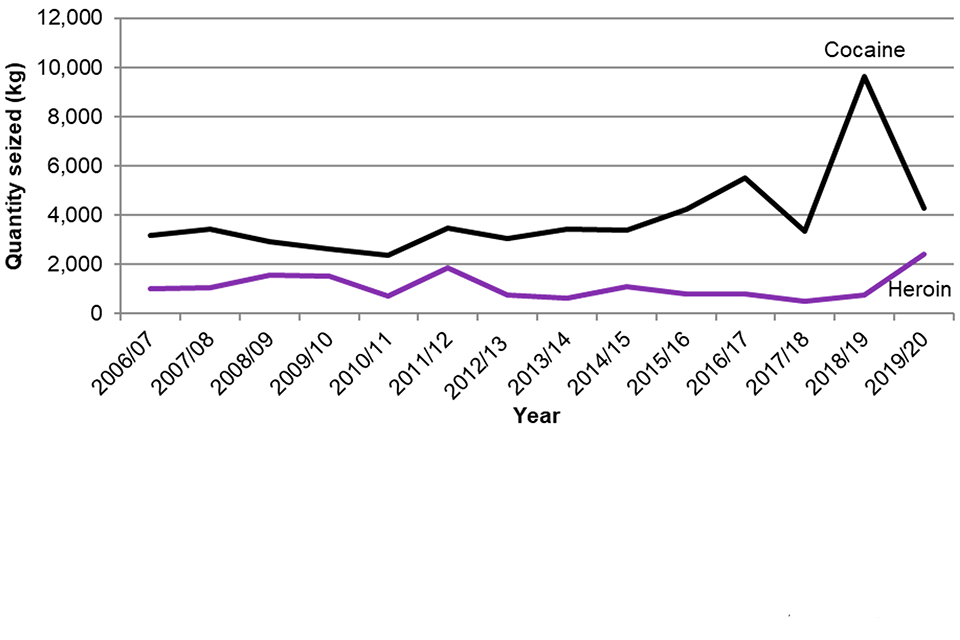
Source: Home Office, Summary Table 2
- As shown in Figure 7, 57% of heroin seizures in the year ending March 2020 weighed under 1g, 42% weighed between 1g to <500g, and the remaining 1% weighed 500g or more. The distributions of cocaine seizures by weight were similar, with 60% under 1g and 38% between 1g and <500g and the remaining 1% weighing 500g and over. For crack seizures, 57% weighed under 1g, 43% weighed between 1g and <500g and 0.001% weighed 500g and over (1 seizure). Chapter 4 covers the quantities of drugs seized by authority.
Figure 7: Distribution of quantities of Class A drugs seized, summarised in grams, police forces and Border Force, year ending March 2020
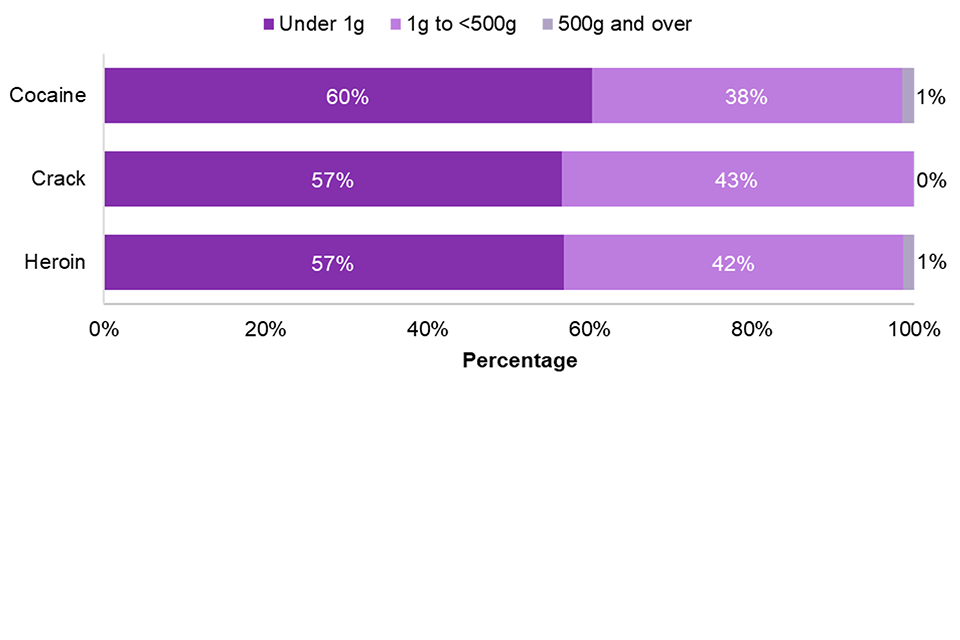
Source: Home Office, Summary Table 3. Numbers may not sum to 100% due to rounding.
- The quantity of ecstasy seized declined from 2.2 million to 2 million doses between the years ending March 2019 and 2020, following increases in the quantity of ecstasy seized since year ending March 2017. These increases are largely driven by Border Force seizures, which increased from 264,631 doses in the year ending March 2017 to 1,364,798 doses in year ending March 2020. The 2 million doses of ecstasy seized by police forces and Border Force in the latest year are among the highest quantity seized since year ending March 2007 and is only surpassed by year ending March 2019.
- As shown in Figure 8, 57% of ecstasy seizures in the year ending March 2020 involved 10 or fewer doses, 31% involved over 10 doses and 12% were unknown (Border Force).
- Seizures of LSD by police forces and Border Force increased by 230% from 54,070 to 178,193 doses between years ending March 2019 and 2020 This was driven by a notable increase in the quantity of LSD seized by Merseyside Police, who seized 154,599 doses of LSD in in the year ending March 2020 (87% of the total amount of LSD seized during that year).
- The quantity of morphine seized decreased by 43% from 21,831 to 12,412 doses between years ending March 2019 and 2020.
- The quantity of methadone seized increased by 45%, from 30,303 to 43,993 doses between years ending March 2019 and 2020.
- A total of 304 doses and 84kg of fentanyl and fentanyl analogues were seized by police forces and Border Force in the year ending March 2020. Border Force seized almost 100% of weighed fentanyl (84kg).
Figure 8: Distribution of quantities of Class A drugs seized, summarised in doses, police forces and Border Force, year ending March 2020
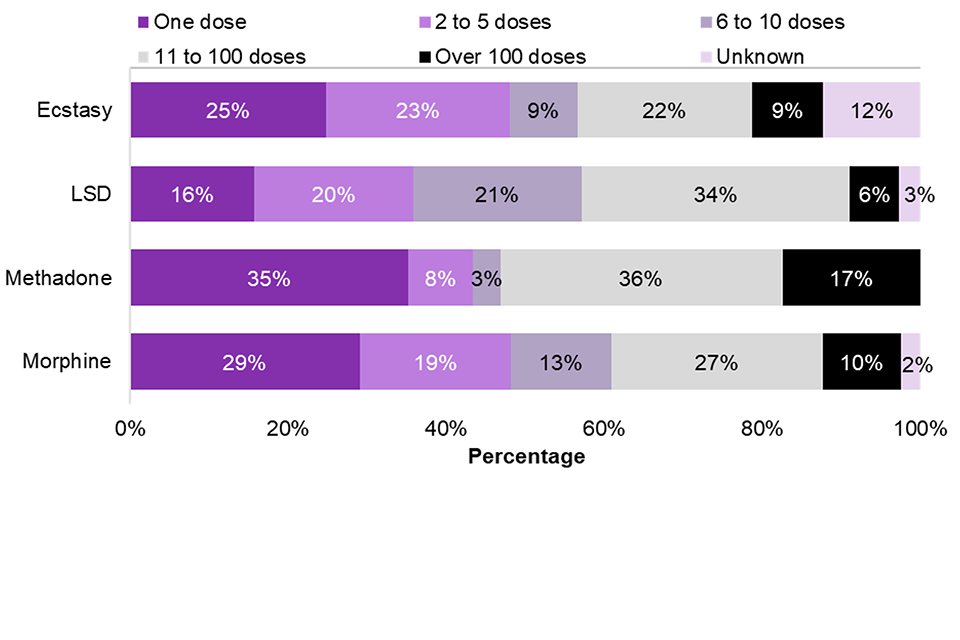
Source: Home Office, Supplementary Table 2. Numbers may not sum to 100% due to rounding.
3.2 Class B drugs
3.2.1 Cannabis
- The total quantity of herbal cannabis seized in the year ending March 2020 increased by 23% from the previous year, from 16,692kg to 20,560kg. As shown in Figure 9, this is after a considerable fall in the quantity of herbal cannabis seized in year ending March 2019 (16,692kg) compared with the previous year (28,669kg). The vast majority of herbal cannabis tends to be seized by Border Force, so large fluctuations in the total amount of herbal cannabis seized have been mostly driven by Border Force seizures.
- The increase over the last year is driven by a 30% increase in the quantity of herbal cannabis seized by Border Force, from 11,646kg in the year ending March 2019 to 15,166kg in the latest year. Border Force made 28 seizures of herbal cannabis of 100kg and over in year ending March 2020. The quantity of herbal cannabis seized by police forces also increased over this period by 7% (5,046kg to 5,394kg).
- The total quantity of cannabis resin seized in the year ending March 2020 decreased by 81% compared with the previous year, from 4,626kg to 871kg. The quantity of cannabis resin seized by Border Force decreased by 84% (from 4,169kg to 673kg), and the quantity seized by police forces decreased by 57% (from 457kg to 198kg).
- In the year ending March 2020, a total of 490,254 cannabis plants were seized, an increase of 24% since the previous year when 395,843 plants were seized.
Figure 9: Quantity of cannabis seized, police forces and Border Force, years ending March 2007 to 2020
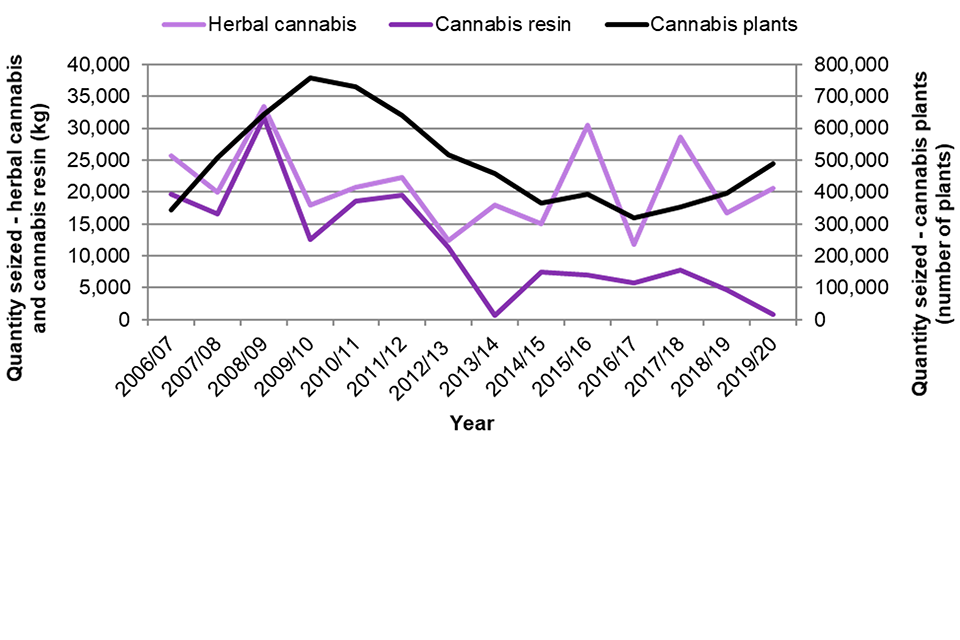
Source: Home Office, Summary Table 2.
- As shown in Figure 10, 16% of cannabis resin seizures in the year ending March 2020 weighed less than 1g, 11% weighed between 1g and <5g, and the remaining 73% weighed 5g or more.
- In contrast, 18% of herbal cannabis seizures weighed less than 1g, 54% weighed between 1g and <5g, and the remaining 28% weighed 5g and over.
Figure 10: Distribution of quantities of herbal cannabis and cannabis resin seized, police forces and Border Force, year ending March 2020
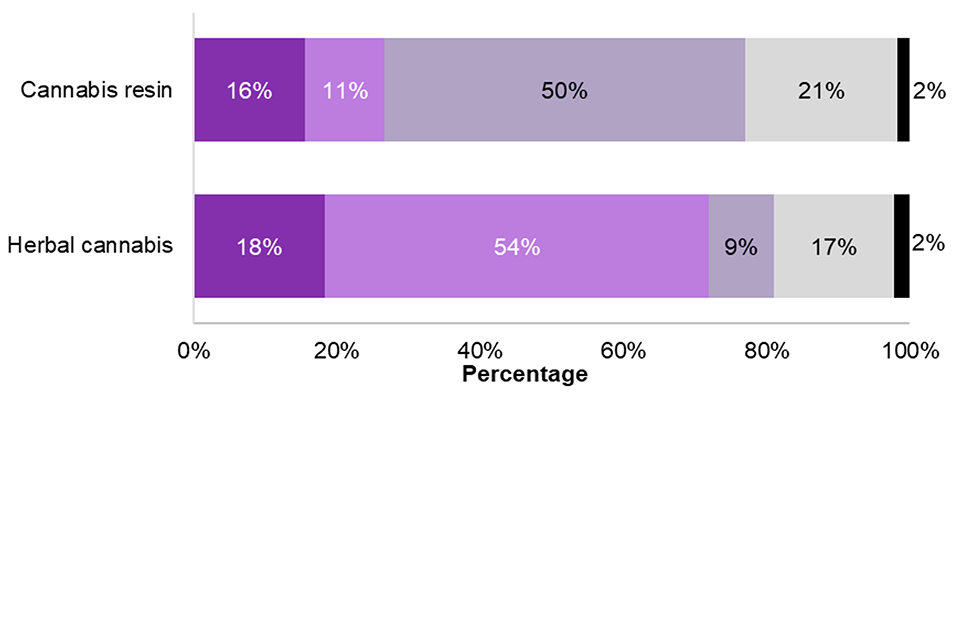
Source: Home Office, Supplementary Table 2. Numbers may not sum to 100% due to rounding.
- As shown in Figure 11, 45% of cannabis plant seizures involved 5 plants or fewer in 2019/20, 14% involved 6 to 10 plants, and the remaining 41% involved 11 plants or more.
Figure 11: Distribution of quantities of cannabis plants seized, police forces and Border Force, year ending March 2020

Source: Home Office, Supplementary Table 2. Numbers may not sum to 100% due to rounding.
3.2.2 Other Class B drugs
- There were 67kg of ketamine seized in the year ending March 2020, a 57% decrease from the previous year when 155kg were seized. This was driven by a 72% fall in the quantity seized by Border Force (from 133kg to 37kg), while there was a 31% increase in the quantity seized by police forces (from 23kg to 30kg).
- In the year ending March 2020 there were 458kg of amphetamines seized, a 31% decrease on the previous year when 668kg were seized.
- As shown in Figure 12, the majority of seizures of ketamine and amphetamines weighed less than 500g, with 44% of ketamine seizures and 47% of amphetamines seizures weighing less than 1g.
Figure 12: Distribution of quantities of ‘Other Class B’ drugs seized, police force and Border Force, year ending March 2020

Source: Home Office, Summary Table 3. Numbers may not sum to 100% due to rounding.
3.3 Class C drugs
- The total quantity of anabolic steroids seized decreased by 50% from 2.7 million doses to 1.3 million doses between years ending March 2019 and 2020. This was driven by a 57% fall in the quantity of anabolic steroids seized over the same two-year period by Border Force, from 2.5 million doses to 1.1 million doses.
- As shown in Figure 13, 27% of anabolic steroid seizures involved 10 doses or less in the year ending March 2020, 26% involved 11 to 100 doses, 25% involved over 100 doses and 21% were unknown.
Figure 13: Distribution of quantities of anabolic steroids, police forces and Border Force, year ending March 2020

Source: Home Office, Summary Table 3. Numbers may not sum to 100% due to rounding.
- The total quantity of benzodiazepines seized increased by 51% between the years ending March 2019 and 2020, from 567,275 doses to 856,951 doses.
- The quantity of GHB seized fell by 85% from 0.7kg in the year ending March 2019 to 0.11kg in the latest year.
- There were 2,734 doses of temazepam seized in the year ending March 2020, a 149% increase from the previous year when 1,100 doses were seized.
4. Seizures by authority
This chapter looks at the seizures of drugs by authority, separating seizures made by Border Force from those seizures made by the police. Seizures from joint operations involving Border Force and the police are recorded against the lead agency that takes possession of the seized drugs. Although Border Force will have made seizures outside the land territory of England and Wales (e.g. Scotland, Northern Ireland), such seizures are excluded from figures presented in this publication.
4.1 Number of seizures
Table 3 shows the number of seizures made by police forces and Border Force for each class of drug. In the year ending March 2020, 92% of seizures were made by police forces (169,224); the remaining 8% (13,844) were made by Border Force.
Table 3: Number of seizures made by police forces and Border Force, years ending 2019 and 2020
| Police forces FYE 2019 | Police forces FYE 2020 | Police forces % change | Border Force FYE 2019 | Border Force FYE 2020 | Border Force % change | |
|---|---|---|---|---|---|---|
| Class A | 30,961 | 33,140 | 7 | 1,793 | 3,987 | 122 |
| Class B | 109,266 | 130,598 | 20 | 5,781 | 8,193 | 42 |
| Class C | 3,801 | 3,862 | 2 | 1,481 | 1,916 | 29 |
| All | 144,198 | 169,224 | 17 | 8,938 | 13,844 | 55 |
Source: Home Office, Summary Table 1.
- The total number of seizures made by police forces in England and Wales rose by 17% in the year ending March 2020 compared with the previous year, while the total number of seizures made by Border Force over the same time period rose by 55%.
- Police forces accounted for 89% of all seizures of Class A drugs, 94% of all seizures of Class B drugs and 67% of seizures of Class C drugs, which is similar to previous years.
- For Class A seizures, police forces were responsible for almost 100% of crack cocaine seizures, the majority of heroin (98%), cocaine (97%), morphine (96%) and ecstasy (77%) seizures and a minority of LSD (40%) seizures, as shown in Figure 14.
- For Class B seizures, police forces were responsible for 95% of cannabis, 92% of amphetamine seizures and 94% of ‘Other Class B’ seizures.
- For Class C seizures, Border Force were responsible for 45% of anabolic steroids seizures.
Figure 14: Proportion of drug seizure numbers by drug type and authority, year ending March 2020

Source: Home Office, Summary Table 4.
4.2 Quantity of seizures
Although Border Force accounted for just 8% of drug seizures in the year ending March 2020, the proportion they seized in terms of quantity was much larger. This is because the agency is often involved in operations where large quantities of drugs are seized, for example at airports or ferry ports.
- For Class A seizures, Border Force seized 88% of the total quantity of cocaine seized (3,755kg), 92% of heroin (2,210kg) and 67% of ecstasy (1.4 million doses) as shown in Figure 15.
- For Class B seizures, Border Force seized 74% of herbal cannabis (15,166kg), 77% of cannabis resin (673kg), and 56% of ketamine (37kg).
- For Class C seizures, Border Force seized 79% of anabolic steroids (1.1 million doses).
Figure 15: Proportion of drug seizure quantities by drug type and authority, year ending March 2020

Source: Home Office, Summary Table 5.
In general, Border Force seized much larger quantities of drugs, per seizure, than police forces. For drugs measured in grams, 29% of seizures by police forces weighed under 1g, compared with 2% of seizures made by Border Force. For drugs measured in doses, 80% of seizures by police forces involved fewer than 50 doses, compared with 32% of seizures made by Border Force. A further breakdown by drug type is provided in Figure 16 to Figure 19.
Figure 16: Distribution of drug seizure quantities of cocaine by authority, year ending March 2020 and Figure 17: Distribution of drug seizure quantities of heroin by authority, year ending March 2020
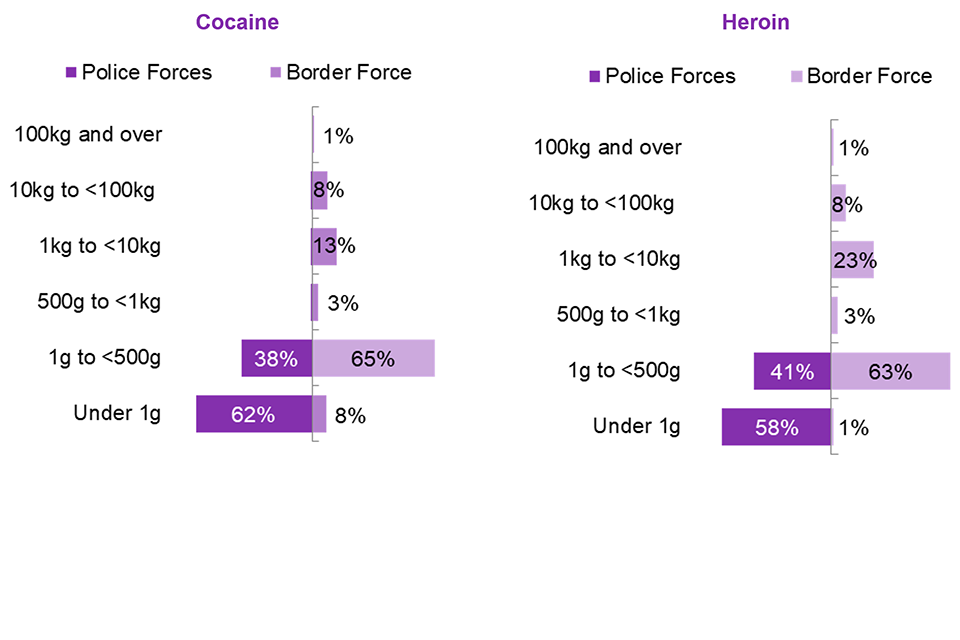
Figure 18: Distribution of drug seizure quantities of herbal cannabis by authority, year ending March 2020 and Figure 19: Distribution of drug seizure quantities of ecstasy by authority, year ending March 2020
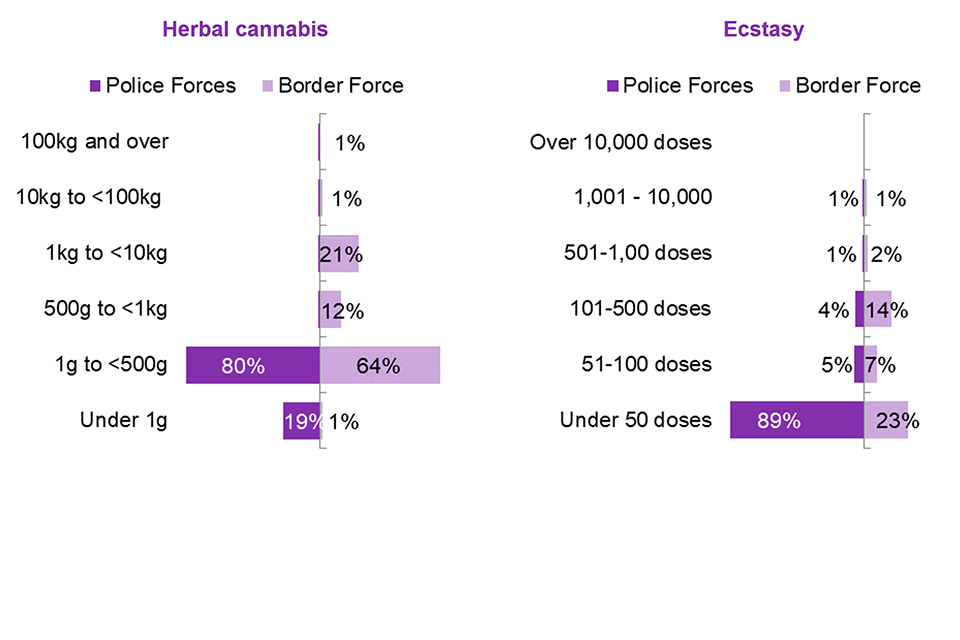
Source: Home Office, Summary Table 3. Numbers may not sum to 100% due to rounding. In Figure 19, Border Force’s numbers do not sum to 100% because only 377 out of a total of 803 of Border Force’s ecstasy seizures were recorded in units, and the remaining ecstasy seizures were recorded in kilograms and therefore do not fit under one of the quantity bands.
5. New psychoactive substances
NPS refers to newly available drugs that mimic the effect of existing drugs such as cannabis, ecstasy and powder cocaine. Some NPS are controlled under the MDA[footnote 18], while other NPS are illegal to supply, produce and import under the Psychoactive Substances Act 2016[footnote 19]. In the year ending March 2018, figures for seizures of NPS were presented in this publication for the first time. Data is presented for years ending March 2019 and 2020, however these statistics remain as designated Experimental Statistics, as they are not yet fully developed and do not meet the rigorous quality standards of Official Statistics.
Seizures of NPS have been grouped into four categories: nitrous oxide, NPS powders, synthetic cannabinoids and other NPS (including pills). Seizures of synthetic cannabinoids are also counted against the ‘Other Class B’ category, as the ‘third generation’ of synthetic cannabinoids were controlled as Class B substances in December 2016[footnote 20].
5.1 Number of NPS seizures
- There were 2,667 seizures of NPS by police forces in the year ending March 2020, a 2% decrease from the previous year (2,717)[footnote 21].
- As shown in Figure 20, synthetic cannabinoids were the most often seized category of NPS (2,055 seizures by police forces). This is a 5% decrease from 2,170 police force seizures in the previous year.
- The number of seizures of NPS powders by police forces and Border Force increased by 1% from 250 to 253, and nitrous oxide seizures increased from 247 to 256 seizures (4% increase).
- Seizures of other NPS increased by 87%, from 310 to 581 seizures in the years ending March 2019 and 2020.
- Police forces were responsible for 94% of nitrous oxide seizures, 47% of other NPS seizures and 38% of NPS powder seizures.
Figure 20: Number of NPS seizures by drug type and authority, years ending March 2019 and 2020
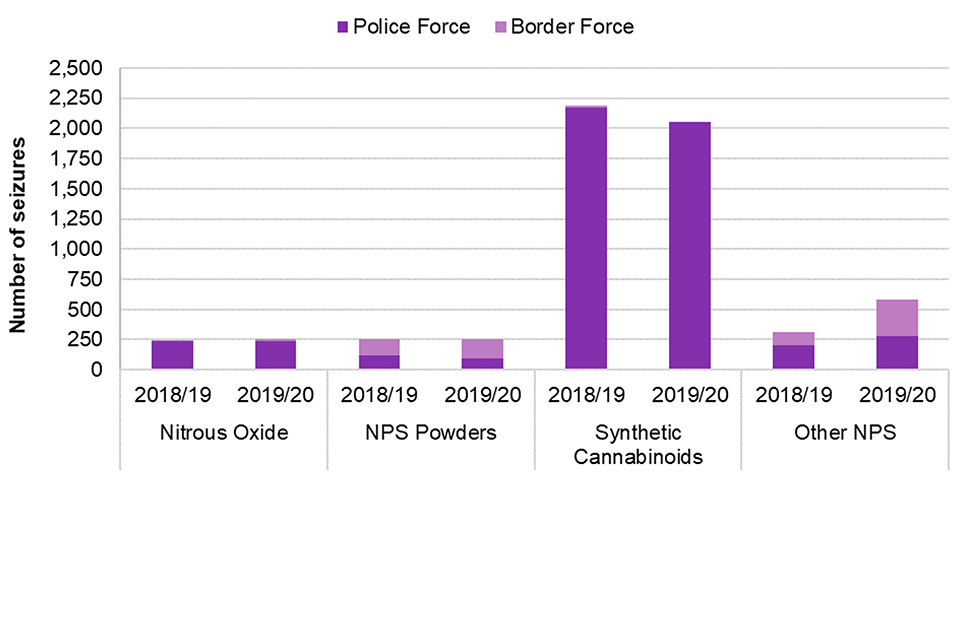
Source: Home Office, Appendix Table 1[footnote 22].
5.2 Quantity of NPS seizures
The quantities of drugs seized are summarised in terms of kilograms for NPS powders and are summarised in doses for nitrous oxide. ‘Other NPS’ seizures and synthetic cannabinoids have been presented with separate figures for kilograms and doses.
- A total of 308,538 doses of nitrous oxide were seized by police forces and Border Force in the year ending March 2020[footnote 23], 84% of which was seized by Border Force (Figure 21). This is an 82% decrease from the previous year (1,713,584 doses).
- As shown in Figure 22, a total of 24,373 doses of other NPS were seized by police forces and Border Force in the year ending March 2020, of which 79% (19,174 doses) were seized by Border Force. As shown in Figure 23, a total of 99kg of other NPS were seized, of which 97% (96kg) were seized by Border Force. This is a 98% decrease from the previous year (4,887kg).
- A total of 4,341 doses of synthetic cannabinoids were seized by police forces in the year ending March 2020, 97% more than in the previous year (2,207 doses by police forces) (Figure 22). As shown in Figure 23, a total of 61kg of synthetic cannabinoids was seized by police forces in the year ending March 2020. This is an 8% decrease from the previous year (66kg by police forces).
- A total of 203kg of NPS powders were seized in the year ending March 2020, a 96% decrease from the previous year (1,559kg). Border Force seized 96% and police forces seized under 8kg (Figure 23).
Figure 21: Quantities of Nitrous Oxide seized (doses) by authority, years ending March 2019 and 2020
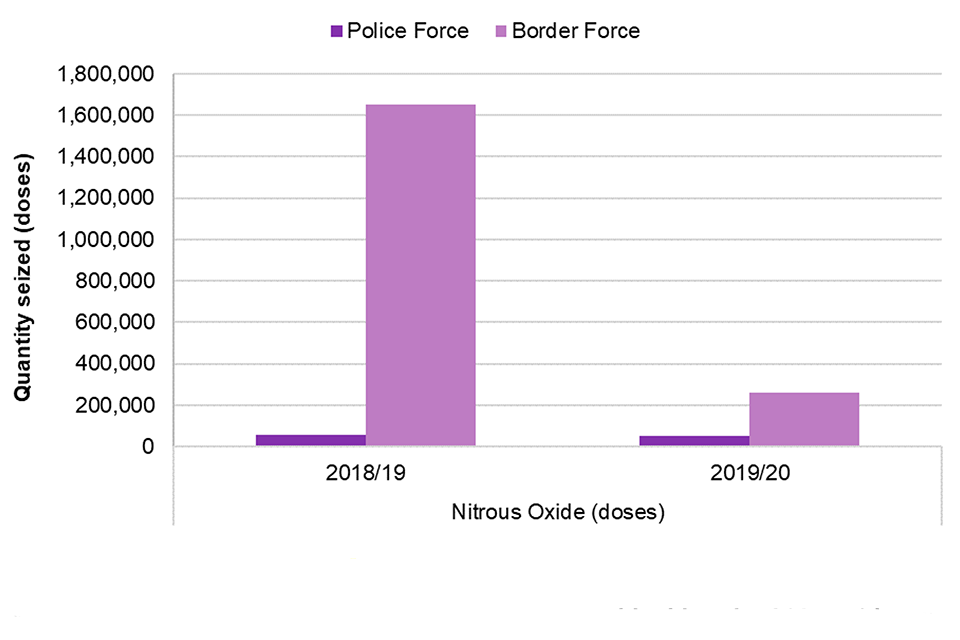
Source: Home Office, Appendix Table 2.
Figure 22: Quantities of Other NPS and Synthetic Cannabinoids seized (doses) by authority, years ending March 2019 and 2020

Source: Home Office, Appendix Table 2.
Figure 23: Quantities of NPS drugs seized by drug type and authority, summarised in kilograms, years ending March 2019 and 2020

Source: Home Office, Appendix Table 2.
6. Data quality and interpreting the figures
The statistics in Seizures of drugs in England and Wales relate to the seizures of drugs controlled under MDA 1971, which came into force on 1 July 1973, and the Psychoactive Substances Act (PSA) 2016, which came into force on 26 May 2016. They cover seizures made during the year by police forces in England and Wales (including the British Transport Police) and Border Force (formerly part of the UK Border Agency). Although Border Force will have made seizures outside the land territory of England and Wales (e.g. Scotland, Northern Ireland), such seizures are excluded from figures presented in the publication. Seizures from joint operations involving Border Force and the police are recorded against the lead agency that takes possession of the seized drugs.
Where a seizure is made of a drug not separately listed in this bulletin, it is aggregated into an ‘other’ category based on its class, for example ‘Other Class A’ for Class A drugs. Further information on drugs covered under the MDA, including a link to the full list of drugs covered, is available at: Misuse of Drugs Act 1971. Information on the PSA is available at: Psychoactive Substances Act 2016. Details about the counting rules used for calculating numbers of seizures in this bulletin are included in the user guide.
6.1 Imputation
Five police forces (Hertfordshire Constabulary, Kent Police, Lincolnshire Police, Sussex Police and Greater Manchester Police) were unable to provide fully accurate data for the year ending March 2020. As a result, data and imputation methods have been used to estimate data for these forces. Further information on estimations, including those made in previous years, can be found in the introduction of the user guide.
6.2 Revision policy
Police forces can resubmit historical data whenever they wish. All figures quoted in this release are correct at the time of publication and reflect the latest revisions made by police forces; therefore, figures published in this release supersede all previously published data. Data for Border Force are only revised once a year (the year after the period they refer to).
In 2019 the Home Office moved its drug seizures records to a different database. Drug seizures figures from previous years have not been revised following this change, but historical figures may be revised in future publications, which is expected to lead to small changes in drug seizures figures but unlikely to affect overall trends. We will inform users of these statistics of any revisions made in future publications.
Further information on the data collection process, and quality assurance of the data, can be found in Appendix A of the user guide.
7. Other data sources
7.1 Seizures by police in Scotland and Northern Ireland
As well as providing a comparison to seizures in England and Wales, drug seizure figures for Scotland and Northern Ireland give a more complete UK-wide picture. Data relating to seizures of drugs by the police in Scotland are collected and published by the Scottish Government[footnote 24].
Prior to the year ending March 2015, the Scottish Government used the same counting rules and broad methodology as for England and Wales. However, since then they have changed the data collection process, splitting seizures into supply and possession offences, and using extrapolation methods to estimate the latter from a sample. As a result, the figures from Scotland are not directly comparable with those from England and Wales.
The Police Service of Northern Ireland (PSNI)[footnote 25] collects and publishes data on drug seizures by police in Northern Ireland, and they are also presented on the same basis as those for England and Wales.
7.2 Border Force seizures
Seizures made by Border Force officials outside England and Wales (e.g. Scotland, Northern Ireland) are excluded from figures presented in this statistical release. A quarterly breakdown of Border Force seizures in the UK is available online as part of their regular key performance indicators[footnote 26].
7.3 Misuse of drugs
The extent and trends in illicit drug use among adults aged 16 to 59 is measured by the Crime Survey for England and Wales (CSEW). The latest results covering the year ending March 2020 were published by ONS on 9 December 2020. According to the CSEW for the year ending March 2019, around 1 in 11 (9.4%) adults had taken any illicit drug in the last year, similar to the previous year (9.0%) and similar to over a decade ago (9.9% in the year ending March 2009 survey)[footnote 27].
The Smoking, Drinking and Drug Use among Young People in England[footnote 28] is published by NHS Digital and contains results from a biennial survey of school children aged 11 to 15. Based on the 2018 survey, 24% of pupils reported they had ever taken drugs, the same as in 2016 and similar to over a decade ago (25% in 2007).
-
See the latest edition of Drug Misuse: Findings from the 2019 to 2020 CSEW. ↩
-
See the latest edition of Smoking, Drinking and Drug Use among Young People in England. ↩
-
Statistics on historical seizures of drugs in England and Wales can be found in the web archive. ↩
-
Ibid. ↩
-
Includes data from HM Revenue and Customs (HMRC) up to and including year ending March 2011. Statistics on historical seizures of drugs in England and Wales can be found in the web archive. ↩
-
See the Misuse of Drugs Act 1971. ↩
-
See the Psychoactive Substances Act 2016. ↩
-
Where a seizure is made of a drug that is not listed in the above, it is aggregated into an ‘other’ class category. Further information on drugs covered under the MDA is provided in the government’s controlled drugs list. ↩
-
Figures include estimates for Hertfordshire Constabulary, Kent Police and Lincolnshire Police for the year ending March 2019 and Hertfordshire Constabulary, Kent Police, Lincolnshire Police, Greater Manchester Police and Sussex Police for year ending March 2020. ↩
-
See the latest edition of Drug Misuse: Findings from the 2019 to 2020 CSEW. ↩
-
See the latest edition of Smoking, Drinking and Drug Use among Young People in England. ↩
-
Statistics on the number of police recorded drug offences are published on a quarterly basis by ONS. ↩
-
This includes offences for possession of controlled drugs, trafficking in controlled drugs, and other drug offences. ↩
-
See the latest edition of Police powers and procedures. ↩
-
Statistics on historical seizures of drugs in England and Wales can be found in the web archive. ↩
-
Fentanyl data from years ending March 2007 to 2018 excludes Sussex, as reliable data was not available. ↩
-
Examples of ‘Other Class C’ drugs are Tramadol, Zopiclone and Khat. Border Force also include Benzodiazepines, GHB and Temazepam in the ‘Other Class C’ category. ↩
-
See the Misuse of Drugs Act 1971. ↩
-
See the Psychoactive Substances Act 2016. ↩
-
See the Explanatory Memorandum, Home Office, 2016. ↩
-
Border Force were unable to provide separate figures for total NPS and synthetic cannabinoids seizures in the year ending March 2020. ↩
-
Synthetic cannabinoids figures exclude Border Force seizures for year ending March 2020, so these figures are not directly comparable. ↩
-
Border Force were unable to provide separate figures for total NPS and synthetic cannabinoids seizures in the year ending March 2020. ↩
-
Latest drug seizure statistics for Scotland were published in March 2019 and are available online at: The Scottish Government website. ↩
-
Latest drug seizure statistics for Northern Ireland are published monthly, and are available online at: Police Service of Northern Ireland website. ↩
-
Border Force publishes data on its key performance indicators at Border Force transparency data. ↩
-
See the latest edition of Smoking, Drinking and Drug use among Young People in England. ↩
